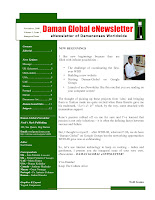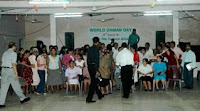Call the chilli by any other name!!
Portuguese-based Creole of Damao came closest to Standard Portuguese in the seven years or so preceding the liberation in 1961 during the time the Portuguese troops camped in Daman. This is also the period when the Indo-Portuguese culture leaned more on the European side, again, as a result of the influence of the troops and their families.
Further, this happened more in Small Daman than Big Daman as most of the troops and their families lived there. Also, almost all of the elite of Damanense society lived in Small Daman. It was the elite of that time that interacted most with the ‘White’ officers and their families. Hence the slight difference in the Portuguese of Small Daman and Big Daman.
Even the same dishes are named differently in Small Daman and Big Daman, eg., a common fish dish is called, ‘Coco manteiga’ in Small Daman and ‘Caldo doce’ in Big Daman; a Christmas sweet is called, ‘Teia de aranha’ in Small Daman and ‘Aranha do ceu’ in Big Daman; a blossom is called, ‘flora de ice cream’ in Small Daman and ‘Coco ralado’ in Big Daman; a roadside flower is called, ‘Flora de ardoza’ in Small Daman and ‘Flora de Virgem Maria’ in Big Daman. (Excuse the spellings:)
When the Portuguese left in 1961, there was an exodus of the locals too, mostly from Small Daman when most of the elite left. Big Daman became the new seat of Indo-Portuguese culture by default – it had more catholics and it’s original creole and Indo-Portuguese culture was not affected much during the last seven years of the Portuguese as Small Daman was.
But the language is certainly not dying despite the convent school discontinuing Portuguese as a second language and more and more Goan priests who do not know the language being posted in Daman not to mention the large numbers of south Indian Christians in Small Daman. The number of people speaking Portuguese as their mother tongue may be declining for the simple reason that they’re migrating to the UK and definitely not because they’re switching to another language as has happened in other parts of India where P’guese based creole was spoken. Not only that – quite a few traders/shop-keepers in Big Daman who migrated to Daman (Rajashtanis being the most prominent) as recently as five years ago, speak Portuguese with their Portuguese-speaking customers!
Well, for good or for bad, Damanense Portuguese says it best – people feel they heard a ‘real’ mass when it’s said in P’guese and nothing could give them more satisfaction than using a P’guese swear word… the English SOB is a sob before it’s P’guese translation. And there’s a variation that was used by the Pguese to name a local chilli!!
Eu Falo Português!
The topic about the Portuguese language spoken in Daman by Damanenses is very popular on the forums.
Here’s my take on the current status of the language…
There are four main types of Portuguese in today’s Daman:
1. The most popular is the ‘remix’ version – Portuguese (ungrammatical), garnished with English words, a dash of Gujarati and of late, a sprinkling of Hindi! This is spoken by everyone up to the age of 50 to 55. If you’re at a distance where the speech is audible but the words are not decipherable, the ‘tune’ is Gujarati! To cite an example, I was attending mass in the Se Cathedral in the Fort a few years back when a group of Portuguese tourists entered from the main door. The mass was in Portuguese and therefore, the choir was singing a Portuguese hymn. A good three minutes into the hymn, one of the Portuguese men tapped the shoulders of his colleagues and whispered, “E Portugues!”
2. Badrapor Portuguese – same as above but grammatically the most incorrect and with a few dozens of words that are said to be ‘original’ Portuguese and decidedly old. Badrapor Portuguese is romanticized the most by Westerners and locals ‘scholars.’
3. The Portuguese spoken by those who studied it at least up to ‘segunda grau.’ These are in the age group of 55+ and have also studied English post-liberation. They are the self-appointed ambassadors of the Indo Portuguese culture of Daman, forming a closely knit circle that is as impenetrable as the forts of Daman. They swear by ‘Badrapor Portuguese,’ but try to speak their best ‘European Portuguese’ in the presence of whites. Interestingly, they speak the ‘remix’ version amongst themselves and in their homes:)
4. The Portuguese spoken by the endangered species of Damanenses in Daman – the erstwhile elite of Damanense society, who speak grammatically correct though ‘old’ Portuguese, even in their underwear – before whites as well as amongst themselves in their own homes. They are old, 70+, have an old-world aura, old-world values and have seen or rather heard it all but have chosen to remain silent and let the babble go on and on…
Noel Gama
Daman
The general public of Daman was caught unawares when the police descended on them on the night of 19th November (2008). Many were returning from work or from shopping, others were just relaxing on municipal benches and public places and the yet others were in bars when jeep-loads of police accosted and indiscriminately beat up people all over Daman (Nani/Moti) and then herded them to the police station.
Those on mobikes were stopped and thrashed. It is reported that even some people who were still shopping, were beaten and the tables of those sitting outside bars, smashed to pieces. Those locked up were released around 2pm the next day.
Neither the victims nor the general public seem to know what hit them! It is alleged that when the victims tried to contact the local politicians, they discovered that they’d switched off their mobiles.
It is rumoured that the policemen were from neighbouring Silvassa. It is also rumoured that the Gujarat police were conducting a search for terrorists in Daman at the same time!
Another curious thing – only men, mostly young, were beaten up.
Since the 19th, people don’t venture out after dark. Bars – the only nightlife you see in Daman – wear a deserted look. It is rumoured that no more than four can seat at each table though there’s been no official notification of any kind… only rumours and more rumours!
DAMAN GLOBAL eNEWSLETTER – Inaugural Issue uploaded!

Daman’s first global eNewsletter has been released today – 6th November, 2008!
You can download your copy (PDF) here:
http://public.me.com/noelgama
Viva!
Noel
“Discover Daman” Homepage up!!

The homepage of my content-based theme site, “Discover Daman” just
went up!
Tier-2 and tier-3 pages will start going up in the days and
months that follow.
Check out the homepage here and let me know what you think: www.Discover-Daman.com
Viva Damão! Keep the culture alive: First “WORLD DAMAN DAY” Celebrated Worldwide on 20th August 2008


The first-ever, “WORLD DAMAN DAY” was celebrated by people of Daman origin living outside India in countries like the UAE, USA, Canada, Holland, Macau, Portugal and the UK along with the 9th “World Goa Day” on invitation from its London-based founder, Rene Barreto. The month-long celebrations were undoubtedly, the biggest worldwide Damanense party in the history of Daman!
World Daman Day like World Goa Day, is primarily celebrated outside of India in an effort to first establish identity and later turn it into a brand as Goa has already done. The date, though significant for Goa vis-à-vis the status of the Konkani language, isn’t of any significance to Daman. But there was the benefit of getting a helping hand from the much-experienced organizers of WGD. In any case, ultimately, it was the spirit that counted and which turned a black number on the calendar into a red-letter day!
The theme for World Daman Day ’08 was, “Viva Damão! Keep the culture alive!” The imposing centuries-old monuments, customs and traditions have withstood the test of time – all 450 years of them – but it is the culture that breathes life into them.
The motto was to promote, publicize and celebrate all things Damanense by showcasing the unique Damanense cultural heritage, expressed culturally and artistically.
Cock in the shadow of the peacock
A heady blend of Indian and Portuguese cultures, the Indo-Portuguese subculture of Daman is obviously multicultural, multilingual and multiracial yet always in beautiful melodic harmony. When the Portuguese spelling of the word, ‘Daman’ is broken up into its two syllables, it reveals the secret behind the characteristic hospitality of the typical Damanense – ‘Da mão’ – which literally translates as, ‘give me your hand,’ meaning, ‘welcome!’ Says Asunta Franco, Country Coordinator for Fujairah, “You can take a Damanense out of Daman but you can never take Damão out of a Damanense.” It truly is a way of life, for life!
UK – Leicester & Peterborough
The largest body of Damanenses outside India is based in the UK comprising largely Catholics, Hindus and Muslims who have literally transplanted the culture on to British soil. Says Franco Fonseca, Peterborough-based Country Coordinator for the UK, “the British come to observe our social and cultural events but not with the intention of adapting to the culture… they have adoption in mind.” The month-long festival held in Leicester and Peterborough showcased Damanense cuisine, folklore, folksongs, Damanense Mando, Portuguese folk dance, art and sport… “We included games like Sete Telhas, Jili Patta and Inti-tolla even though these are now sidelined in Daman itself,” says Luis Fonseca, Overall Coordinator for Leicester.
UAE – Dubai, Sharjah & Fujairah
The three country coordinators for the UAE organized cultural, culinary and sporting events as well as picnics and excursions, which included a visit to a Portuguese fort in Fujairah. Lysa Lopes, the coordinator for Sharjah, uploaded some of her best Damanense recipes on the WDD-08 website. Tourists to Daman often ask where they can sample Damanense or Indo-Portuguese cuisine. Damanense food is not served in any of the hotels though many label some items on their menu as ‘Daman special.’ The grand finale of the month-long celebrations was in Fujairah, where Damanenses from Sharjah and Dubai joined in a gala event of music, dancing, games and a traditional Damanense dinner.
Daman – Will the real Slim Shady please stand up?
On reading about WDD-08 in the Hindustan Times and the Times of India, Damanenses in Daman too wanted to join in the partying. “The whole world is celebrating and what are we doing about it?” asked Mr. Fremiot Mendonca, the go-to person when researching the local history and culture of Daman. In a matter of minutes, the Damanenses in Daman got their act together, using nothing but their telephones!
The ‘elders’ and the not-so-young were not only more enthusiastic than the youth… they knew what they wanted. Louella Rocha, overall coordinator for Daman, had a list of Do’s & Don’t’s – “no Slim Shady stuff, please… it’s got to be proper ballroom music; no colas, please… it’s got to be wine or rather cake ‘n’ wine; no ‘English’ mass… it’s got to be in Portuguese; no artificial flowers for decking the hall… only ‘kajooree’ palm fronds please…” ‘Viva Damão’ is not just lip service for the Damanenses – it’s the real thing and they don’t just ‘do it’ – they do it right! So, though late in getting into the groove, Damanenses in Daman perceive it as a new beginning and look forward to WDD-09.
Truly global community, bonding on the Internet
During the planning and execution of WDD-08 on a global scale, country coordinators and their team members as well as other Net savvy Damanenses worldwide, made good use of the Internet to achieve so much in so little time – a mere two months from idea to fruition!
The first step was setting up a website at http://web.mac.com/noelgama/wdd08 which was bombarded with traffic minutes after Rene Barreto shot out his press release on the Internet.
As WDD-08 came closer to D-Day, everyone felt that the festival was already turning into a movement! To keep the momentum and meet public demand, “Daman Global” was launched on Google Groups at http://groups.google.com/group/daman-global – a place to network, share news, make announcements and to do what Damanenses do best and enjoy most… gossip!
This is being followed up with the first global eZine, “Daman Global eNewsmagazine” which will bring news updates from all the countries where Damanenses live in. The inaugural issue is being released this month. Subscriptions are accepted online on the WDD-08 website.
A website with the most comprehensive and authoritative information on Daman is being launched next month at www.Discover-Daman.com.
World Goa, Daman & Diu Day ’08
For the first time, Damanenses, especially those in Daman, found that they were doing it for themselves – unlike other times when they’d be programmed to perform the tired ‘vira’ (known locally as ‘Portuguese Dance’) for visiting ministers. The Damanenses in the UK proved that just performing the ‘vira’ on stage is not what culture is about… it’s beyond that, more inclusive and much, much bigger… it’s a way of life – the Damanense way of life.
“Let’s keep the spirit and wish in our hearts – to one day celebrate World Goa, Daman & Diu Day,” says Lysa Lopes, Country Coordinator for Sharjah, UAE. Well, it had always been “Goa, Daman & Diu” until some politicians in Goa decided to delink two of the smaller siblings. Remo Fernandes’ hit song could be tweaked just a bit to make it more specific – “Politicians in Goa don’t know how to do the mando!”
Viva Damão!
Noel
Message from Founder of World Goa Day
World Goa Day is in its ninth year but WORLD DAMAN DAY is in its very first year. The WDD-08 celebrations have come about from a suggestion put by me to Noël Gama in Daman, India two months ago in mid-June. But the progress they have made in those two months is just unimaginable! Noël and his Global team of Damanenses could make any community proud of them. The progress in these celebrations have been exceptional – a very good example for us, Goans.
My congratulations to the people of Daman! I am proud to be associated with the people of Daman and with their overall leader and founder of WORLD DAMAN DAY, Noël Gama!
Rene Barreto
London, UK
World Daman Day – Times of India (VapiPlus) Article
Coming soon… ‘Discover Daman’
The most comprehensive and authoritative site on Daman will be up
soon… maybe the 20th of August?
Here’s some insider info:
It’s an SBI! site – read, ‘theme-based content site.’
The site concept is ‘Daman’
The site name is ‘Discover Daman‘
URL: www.Discover-Daman.com
Viva Damao!
Join “Daman Global” on Google Groups!
As suggested my Rene Baretto quite a number of times, I’ve just created a Google Group titled, “DAMAN GLOBAL” for Damaneses around the world to keep in touch with each other and to network.
Details:
* Group name: Daman Global
*Group home page: http://groups.google.com/group/daman-global
*Group email address daman-global@googlegroups.com
Everyone is invited to go to http://groups.google.com/group/daman-global and join the membership.
Enjoy!
Noel Gama
Daman



